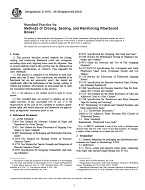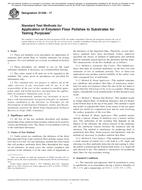1.1 This specification covers annealed titanium and titanium alloy strip, sheet, and plate as follows:
1.1.1 Grade 1 – Unalloyed titanium,
1.1.2 Grade 2 – Unalloyed titanium,
1.1.2.1 Grade 2H – Unalloyed titanium (Grade 2 with 58 ksi minimum UTS),
1.1.3 Grade 3 – Unalloyed titanium,
1.1.4 Grade 4 – Unalloyed titanium,
1.1.5 Grade 5 – Titanium alloy (6 % aluminum, 4 % vanadium),
1.1.6 Grade 6 – Titanium alloy (5 % aluminum, 2.5 % tin),
1.1.7 Grade 7 – Unalloyed titanium plus 0.12 to 0.25 % palladium,
1.1.7.1 Grade 7H – Unalloyed titanium plus 0.12 to 0.25 % palladium (Grade 7 with 58 ksi minimum UTS),
1.1.8 Grade 9 – Titanium alloy (3.0 % aluminum, 2.5 % vanadium),
1.1.9 Grade 11 – Unalloyed titanium plus 0.12 to 0.25 % palladium,
1.1.10 Grade 12 – Titanium alloy (0.3 % molybdenum, 0.8 % nickel),
1.1.11 Grade 13 – Titanium alloy (0.5 % nickel, 0.05 % ruthenium),
1.1.12 Grade 14 – Titanium alloy (0.5 % nickel, 0.05 % ruthenium),
1.1.13 Grade 15 – Titanium alloy (0.5 % nickel, 0.05 % ruthenium),
1.1.14 Grade 16 – Unalloyed titanium plus 0.04 to 0.08 % palladium,
1.1.14.1 Grade 16H – Unalloyed titanium plus 0.04 to 0.08 % palladium (Grade 16 with 58 ksi minimum UTS),
1.1.15 Grade 17 – Unalloyed titanium plus 0.04 to 0.08 % palladium,
1.1.16 Grade 18 – Titanium alloy (3 % aluminum, 2.5 % vanadium) plus 0.04 to 0.08 % palladium,
1.1.17 Grade 19 – Titanium alloy (3 % aluminum, 8 % vanadium, 6 % chromium, 4 % zirconium, 4 % molybdenum),
1.1.18 Grade 20 – Titanium alloy (3 % aluminum, 8 % vanadium, 6 % chromium, 4 % zirconium, 4 % molybdenum) plus 0.04 % to 0.08 % palladium,
1.1.19 Grade 21 – Titanium alloy (15 % molybdenum, 3 % aluminum, 2.7 % niobium, 0.25 % silicon),
1.1.20 Grade 23 – Titanium alloy (6 % aluminum, 4 % vanadium with extra low interstitial elements, ELI),
1.1.21 Grade 24 – Titanium alloy (6 % aluminum, 4 % vanadium) plus 0.04 % to 0.08 % palladium,
1.1.22 Grade 25 – Titanium alloy (6 % aluminum, 4 % vanadium) plus 0.3 % to 0.8 % nickel and 0.04 % to 0.08 % palladium,
1.1.23 Grade 26 – Unalloyed titanium plus 0.08 to 0.14 % ruthenium,
1.1.23.1 Grade 26H – Unalloyed titanium plus 0.08 to 0.14 % ruthenium (Grade 26 with 58 ksi minimum UTS),
1.1.24 Grade 27 – Unalloyed titanium plus 0.08 to 0.14 % ruthenium,
1.1.25 Grade 28 – Titanium alloy (3 % aluminum, 2.5 % vanadium) plus 0.08 to 0.14 % ruthenium,
1.1.26 Grade 29 – Titanium alloy (6 % aluminum, 4 % vanadium with extra low interstitial elements, ELI) plus 0.08 to 0.14 % ruthenium,
1.1.27 Grade 30 – Titanium alloy (0.3 % cobalt, 0.05 % palladium),
1.1.28 Grade 31 – Titanium alloy (0.3 % cobalt, 0.05 % palladium),
1.1.29 Grade 32 – Titanium alloy (5 % aluminum, 1 % tin, 1 % zirconium, 1 % vanadium, 0.8 % molybdenum),
1.1.30 Grade 33 – Titanium alloy (0.4 % nickel, 0.015 % palladium, 0.02 5 % ruthenium, 0.15 % chromium),
1.1.31 Grade 34 – Titanium alloy (0.4 % nickel, 0.015 % palladium, 0.025 % ruthenium, 0.15 % chromium),
1.1.32 Grade 35 – Titanium alloy (4.5 % aluminum, 2 % molybdenum, 1.6 % vanadium, 0.5 % iron, 0.3 % silicon),
1.1.33 Grade 36 – Titanium alloy (45 % niobium),
1.1.34 Grade 37 – Titanium alloy (1.5 % aluminum), and
1.1.35 Grade 38 – Titanium alloy (4 % aluminum, 2.5 % vanadium, 1.5 % iron).
Note 1 – H grade material is identical to the corresponding numeric grade (that is, Grade 2H = Grade 2) except for the higher guaranteed minimum UTS, and may always be certified as meeting the requirements of its corresponding numeric grade. Grades 2H, 7H, 16H, and 26H are intended primarily for pressure vessel use.
The H grades were added in response to a user association request based on its study of over 5200 commercial Grade 2, 7, 16, and 26 test reports, where over 99 % met the 58 ksi minimum UTS.
1.2 The values stated in inch-pound units are to be regarded as standard. The values given in parentheses are mathematical conversions to SI units that are provided for information only and are not considered standard.
Product Details
- Published:
- 04/15/2009
- Number of Pages:
- 10
- File Size:
- 1 file , 120 KB
- Redline File Size:
- 2 files , 220 KB


